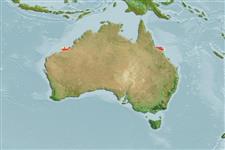>
Blenniiformes (Blennies) >
Blenniidae (Combtooth blennies) > Blenniinae
Etymology: Meiacanthus: Greek, meion = less = lessen + Greek, akantha = thorn (Ref. 45335); luteus: Specific epithet means 'yellow', referring to the brilliant upper body coloration of the species.
Environment: milieu / climate zone / depth range / distribution range
Écologie
marin récifal; profondeur 0 - 35 m (Ref. 7401). Tropical; 19°S - 20°S
Western Pacific: northern Australia, from Western Australia to Queensland.
Taille / Poids / Âge
Maturity: Lm ? range ? - ? cm
Max length : 10.3 cm TL mâle / non sexé; (Ref. 2334)
Description synthétique
Clés d'identification | Morphologie | Morphométrie
Épines dorsales (Total) : 4; Rayons mous dorsaux (Total) : 26 - 28; Épines anales: 2; Rayons mous anaux: 16 - 18. Males with prolonged pelvic fins and caudal-fin lobes; extending from front of snout through eye and caudal-fin base is a midlateral dark brown to black stripe; another dark brown stripe commencing above eye and passing dorsally on body at base of dorsal fin; head and body between 2 stripes bright yellow, below white (Ref. 27362).
Oviparous. Eggs are demersal and adhesive (Ref. 205), and are attached to the substrate via a filamentous, adhesive pad or pedestal (Ref. 94114). Larvae are planktonic, often found in shallow, coastal waters (Ref. 94114). Poisonous canines provide considerable protection from predators.
Life cycle and mating behavior
Maturité | Reproduction | Frai | Œufs | Fécondité | Larves
Oviparous, distinct pairing (Ref. 205).
Randall, J.E., G.R. Allen and R.C. Steene, 1990. Fishes of the Great Barrier Reef and Coral Sea. University of Hawaii Press, Honolulu, Hawaii. 506 p. (Ref. 2334)
Statut dans la liste rouge de l'IUCN (Ref. 130435: Version 2024-2)
Menace pour l'homme
Venomous
Utilisations par l'homme
Outils
Articles particuliers
Télécharger en XML
Sources Internet
Estimates based on models
Preferred temperature (Ref.
123201): 25.8 - 27.3, mean 26.1 °C (based on 52 cells).
Phylogenetic diversity index (Ref.
82804): PD
50 = 0.5000 [Uniqueness, from 0.5 = low to 2.0 = high].
Bayesian length-weight: a=0.00575 (0.00253 - 0.01308), b=3.06 (2.86 - 3.26), in cm total length, based on LWR estimates for this (Sub)family-body shape (Ref.
93245).
Niveau trophique (Ref.
69278): 3.4 ±0.4 se; based on size and trophs of closest relatives
Résilience (Ref.
120179): Haut, temps minimum de doublement de population inférieur à 15 mois (Preliminary K or Fecundity.).
Fishing Vulnerability (Ref.
59153): Low vulnerability (10 of 100).
Nutrients (Ref.
124155): Calcium = 138 [71, 244] mg/100g; Iron = 0.902 [0.532, 1.576] mg/100g; Protein = 17.9 [16.7, 19.0] %; Omega3 = 0.0948 [, ] g/100g; Selenium = 26.2 [12.5, 59.7] μg/100g; VitaminA = 186 [55, 673] μg/100g; Zinc = 2.04 [1.35, 2.94] mg/100g (wet weight);
